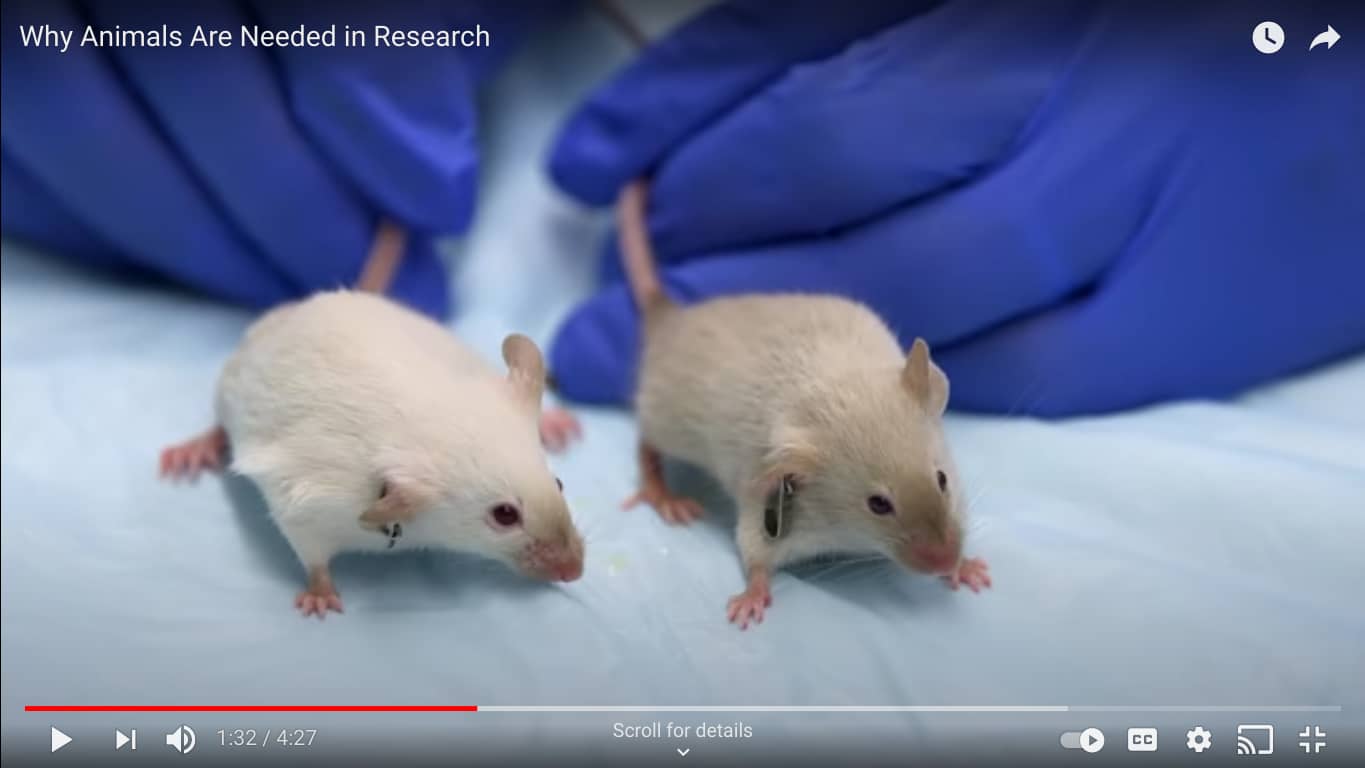“Each year, more than 100 million animals—including mice, rats, frogs, dogs, cats, rabbits, hamsters, guinea pigs, monkeys, fish, and birds—are killed in U.S. laboratories for biology lessons, medical training, curiosity-driven experimentation, and chemical, drug, food, and cosmetics testing.” These animals live a horrible life in these laboratories. These animals have holes drilled into their skills, inhale very toxic fumes, and even have their spinal cords crushed. Along with all the tormenting, these animals are isolated from everything natural and known to them, and put into barren cages. In this video it is stating how animal testing isn’t harmful in away way and that we need it to test products to make sure they are safe. Animals are not needed to see if new products are safe. There are all sorts of new methods and ways to test if products are safe without harming anything or anybody.
“Can’t say anything is safe without it going through a proper set of tests, and these tests have to begin at the level of animals” (0:36)
The first claim in this video is saying that we can’t see if new products and medicines are really safe wthout it going through animal testing first. Scientists have learned to grow human and animal cells in laboratories. They have learned to “Coax cells to grow into 3D structures.” These structures can grow into mini human organs, which then give more realistic ways to test and receive results for new products. People even voluntarily donate their tissues which can provide a more relevant way of studying human diseases. “Human tissue can be donated from surgery (e.g. biopsies, cosmetic surgery and transplants). For example, skin and eye models made from reconstituted human skin and other tissues have been developed and are used to replace the cruel rabbit irritation tests.” Some companies even started making easy to use kits that they sell for other companies to test their products and cosmetics on.
“Oswald Steward, Ph.D. Director Reeve Irvine Research center” (0:25-0:38)
Oswald Steward is the Director of the Reeve-Irvine Research Center at the University of California at Irvine and is a Professor in the Departments of Anatomy & Neurobiology and Neurobiology & Behavior, and Neurosurgery. Dr. Steward is also the Senior Associate Dean for Research at UC Irvine. Oswald researches Spinal cord injury, excitotoxicity,sprouting, epilepsy, regeneration, and animal models of neurodegenerative diseases, but to get results he uses animal testing. “We can’t say if something new is safe or if it works, unless it goes through a proper list of tests, and these tests need to start at the level of animal testing.” said Oswald Steward. “Our leading-edge approach has one clear purpose: to continue to develop, apply and let others know about the research we do to guarantee that our products are safe, without the need for animal testing.” said Julia Fentem, Head of SEAC. “In theory, non-animal tests could be much cheaper and much faster.” said Warren Casey, the director of the U.S. National Toxicology Program’s Interagency Center for the Evaluation of Alternative Toxicological Methods.
Oswald Steward, from the video
“The results we test from animals would be impossible to get results from humans” (1:32)
They are saying that if we test in humans and in petri dishes we won’t be able to get results, and it is impossible to see results even if able to test. Scientists have found a new way to test products. They would start by growing cultured human cells on plastic chips, which these then form these tiny structurces that can mimic a functioning human heart, kidney, liver and the lungs. With these new human like structures, scientists can test the effects of new products on drugs, and they can get realists results. Now with testing on these more human like structures, the results are more realistic then results from animal testing. Scientists have also found other ways of human testing that could reduce animal testing, and is safe for human health. One of these test is microdosing. This process is where humans receive very tiny quantitys of a new drug, so that it doesn’t a huge impact on the humans health, but yet there is just enough of it circulating throughout their system to measure its impact on the cells.
“It’s impossible to see results in humans, and incredibly difficult to see in a tissue culture petri dish.” (1:37)
Brain Brooks, M.D., Ph.D. Chief pediatric Ophthalmology National institute of Health is saying how animal testing in these mice is the only way to see visable, microscopic, and physical changes, which you wouldn’t be able to see in humans or culture petri dishes. Researchers at Technion-Israel Institute of Technology and designed a model to show bacteria mutating when antibiotic drugs are used agaist it. To observe the encounter between them, the researchers “constructed a two-foot by four-foot petri dish – dubbed the Microbial Evolution and Growth Arena or MEGA plate – and filled it with agar, a jellylike nourishment used in labs to feed growing organisms.” “The value of this work is not a clinical model – this doesn’t look like a patient’s leg,” said Brown. In fact the research teams don’t claim their experiments show exactly how bacteria really thrives in the world. Brown also noted “this ‘technically difficult’ experiment offers a more closely related view of real environments than any previous studies.”
“When we test animals in laboratories, not just people benefit from it, animals benefit just as well.” (3:46)
The last claim is saying that these animals are happy getting testing because it is helping them out because humans and animals get some of the same diseases, and if we find cures these will save animals lives. This is true that some animals and humans get the same diseases, but humans get a lot more and different ones. The animals have to go through several tests just to make sure the products are safe. Not only are animals lives wasted, but time and money is also being wasted. Many of the harmful treatments are getting through and the effective and safe treatments are being ‘mistankenly’ discarded. When these animals are being testes, they are getting sickened with by inhaling or injected by toxic chemicals, infected, and they are trapped in these small cages. After these tests and experiments are done these animals are then killed. “PETA’s interactive timeline, features almost 200 stories of twisted experiments, including ones in which dogs were forced to inhale cigarette smoke for months, mice were cut up while still conscious, and cats were deafened, paralyzed, and drowned.”
Conclusion
This topic is very important because many new substances, medicines, and even makeup products are being tested on animals right now, instead of using all these new methods. This is causing millions of animals to loose their lives because of animal testing. If all scientists realized and starting using all these new methods to test if products are safe, we would be saving the lives of millions of innocent animals





What do you think?
Show comments / Leave a comment